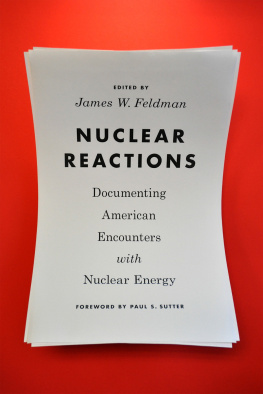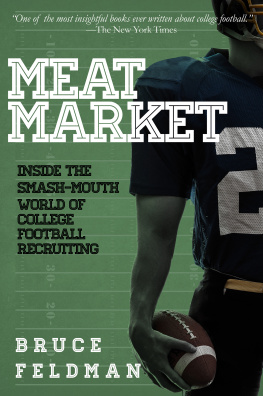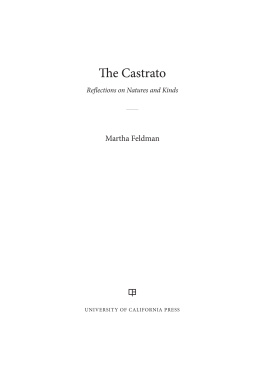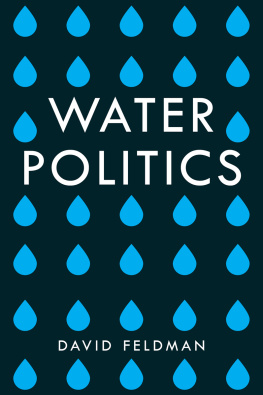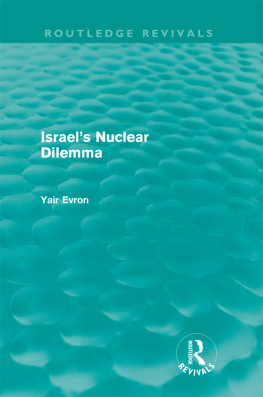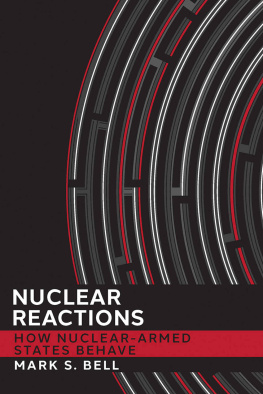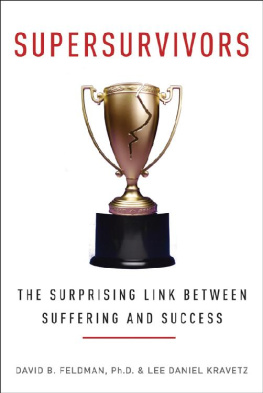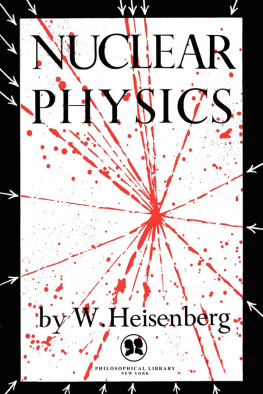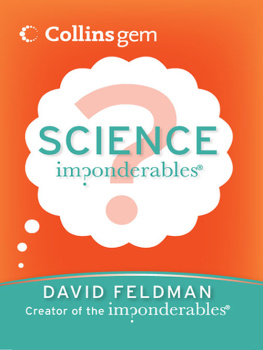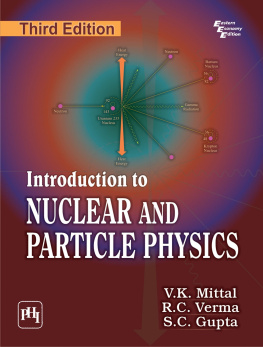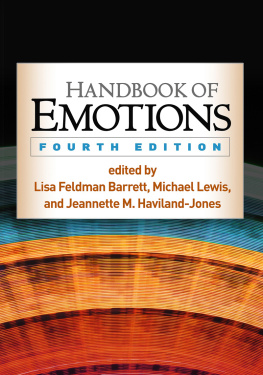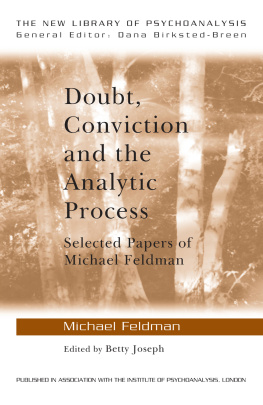Feldman - Nuclear Reactions
Here you can read online Feldman - Nuclear Reactions full text of the book (entire story) in english for free. Download pdf and epub, get meaning, cover and reviews about this ebook. year: 2016, publisher: University of Washington Press, genre: Politics. Description of the work, (preface) as well as reviews are available. Best literature library LitArk.com created for fans of good reading and offers a wide selection of genres:
Romance novel
Science fiction
Adventure
Detective
Science
History
Home and family
Prose
Art
Politics
Computer
Non-fiction
Religion
Business
Children
Humor
Choose a favorite category and find really read worthwhile books. Enjoy immersion in the world of imagination, feel the emotions of the characters or learn something new for yourself, make an fascinating discovery.
- Book:Nuclear Reactions
- Author:
- Publisher:University of Washington Press
- Genre:
- Year:2016
- Rating:3 / 5
- Favourites:Add to favourites
- Your mark:
- 60
- 1
- 2
- 3
- 4
- 5
Nuclear Reactions: summary, description and annotation
We offer to read an annotation, description, summary or preface (depends on what the author of the book "Nuclear Reactions" wrote himself). If you haven't found the necessary information about the book — write in the comments, we will try to find it.
Feldman: author's other books
Who wrote Nuclear Reactions? Find out the surname, the name of the author of the book and a list of all author's works by series.
Nuclear Reactions — read online for free the complete book (whole text) full work
Below is the text of the book, divided by pages. System saving the place of the last page read, allows you to conveniently read the book "Nuclear Reactions" online for free, without having to search again every time where you left off. Put a bookmark, and you can go to the page where you finished reading at any time.
Font size:
Interval:
Bookmark:

WEYERHAEUSER ENVIRONMENTAL CLASSICS
Paul S. Sutter, Editor
WEYERHAEUSER ENVIRONMENTAL CLASSICS
Paul S. Sutter, Editor
Weyerhaeuser Environmental Classics are reprinted editions of key works that explore human relationships with natural environments in all their variety and complexity. Drawn from many disciplines, they examine how natural systems affect human communities, how people affect the environments of which they are a part, and how different cultural conceptions of nature powerfully shape our sense of the world around us. These are books about the environment that continue to offer profound insights about the human place in nature.
Making Climate Change History: Primary Sources from Global Warmings Past, edited by Joshua P. Howe
Nuclear Reactions: Documenting American Encounters with Nuclear Energy, edited by James W. Feldman
The Wilderness Writings of Howard Zahniser, edited by Mark Harvey
The Environmental Moment: 19681972, edited by David Stradling
Reel Nature: Americas Romance with Wildlife on Film, by Gregg Mitman
DDT, Silent Spring, and the Rise of Environmentalism, edited by Thomas R. Dunlap
Conservation in the Progressive Era: Classic Texts, edited by David Stradling
Man and Nature: Or, Physical Geography as Modified by Human Action, by George Perkins Marsh
A Symbol of Wilderness: Echo Park and the American Conservation Movement, by Mark W. T. Harvey
Tutira: The Story of a New Zealand Sheep Station, by Herbert Guthrie-Smith
Mountain Gloom and Mountain Glory: The Development of the Aesthetics of the Infinite, by Marjorie Hope Nicolson
The Great Columbia Plain: A Historical Geography, 18051910, by Donald W. Meinig
Weyerhaeuser Environmental Classics is a subseries within Weyerhaeuser Environmental Books, under the general editorship of Paul S. Sutter. A complete listing of the series appears at the end of this book.
NUCLEAR REACTIONS
Documenting American Encounters with Nuclear Energy
EDITED BY
JAMES W. FELDMAN
UNIVERSITY OF WASHINGTON PRESS
Seattle and London
Nuclear Reactions is published with the assistance of a grant from the Weyerhaeuser Environmental Books Endowment, established by the Weyerhaeuser Company Foundation, members of the Weyerhaeuser family, and Janet and Jack Creighton.
Copyright 2017 by the University of Washington Press
Printed and bound in the United States of America
Design by Thomas Eykemans
Composed in OFL Sorts Mill Goudy, typeface designed by Barry Schwartz
21 20 19 18 175 4 3 2 1
All rights reserved. No part of this publication may be reproduced or transmitted in any form or by any means, electronic or mechanical, including photocopy, recording, or any information storage or retrieval system, without permission in writing from the publisher.
UNIVERSITY OF WASHINGTON PRESS
www.washington.edu/uwpress
Cataloging information is on file with the Library of Congress
ISBN 978-0-295-99962-3
The paper used in this publication is acid-free and meets the minimum requirements of American National Standard for Information SciencesPermanence of Paper for Printed Library Materials, ANSI Z39.481984.
For
Chris, Sam, and Ben
CONTENTS
, by Paul S. Sutter
FOREWORD
Postwar Americas Nuclear Paradox
PAUL S. SUTTER
Some time in the near future, the International Commission on Stratigraphy (ICS) will make a momentous decision: whether or not to designate a new geological epoch called the Anthropocene. This decision, though a complex and technical one, hinges on whether humans have become such a dominant force on this planet that they will leave an unambiguous signature in the earths strata, one that would constitute a clear dividing line in the planets geological history. A collection of scholars known as the Anthropocene Working Group has been tasked with making an initial recommendation to the ICS and with deciding when to date the beginning of the Anthropocene. Although there are several viable contenders, including the onset of the Industrial Revolution and the widespread combustion of fossil fuels that came with it, these scholars are increasingly focused on a more recent beginning point: July 16, 1945, the day that Americans exploded the first atomic bomb in Alamogordo, New Mexico. As a result of that detonation, known as the Trinity Test, as well as the two bombs that the Americans subsequently dropped on Japan and the hundreds of aboveground tests that followed over the next two decades, radioactive debris has settled in sediments all across the planet in ways that will be stratigraphically recognizable for a long time. With nuclear radiation, humankind has etched its signature across the earths surface.
Whether or not the ICS recognizes the Anthropocene as a new epoch with a punctuated beginning in July 1945, it is clear that the dawn of the Atomic Age ushered in a new day in humankinds collective environmental history. The achievement of controlled nuclear reactions capable of generating unfathomable power was a crowning success of modern American science and technology, one that J. Robert Oppenheimer (lead scientist on the Manhattan Project) famously characterized as technically sweet. American and international scientists and engineers had unlocked an elemental source of unbounded energy that promised to change human life on earth. To use an apt metaphor, humankind had harnessed the atom. At the same time, however, many people came to rue the realization of nuclear power as a feat that threatened to destroy the fabric of life on earth. The Promethean act of unleashing the energy of the atom symbolized both unprecedented human mastery of nature and the considerable dangers that came with such comprehensive environmental power and control. Oppenheimer apparently later recognized this too, in an ominous invocation of a verse from the Bhagavad Gita: I am become Death, destroyer of worlds. The very notion of human progress pivoted as a result of this earth-shattering achievement.
In Nuclear Reactions, an essential and timely collection of primary source documents on the history of Americans reactions to nuclear energy, volume editor James W. Feldman helps us to see that the Atomic Age was indeed a profound environmental watershed. This is why this book finds such a comfortable home in the Weyerhaeuser Environmental Classics series. But Feldman also wants us to consider the myriad other ways in which the arrival of nuclear energy shaped postwar American history. If the harnessing of the atom represented a new chapter in the history of human-environmental relationships, it also ushered in a novel moment in the political, social, economic, and cultural history of the United States. Although the environmental frame is thus a necessary and overarching one for understanding American reactions to nuclear energy after World War II, it is not a sufficient one. Indeed, the documents that Feldman has skillfully assembled in Nuclear Reactions show us that nuclear energy not only occupied a central place in postwar American history, but that in the Atomic Age mainstream U.S. history was necessarily environmental history. This collection of classic documents will be as useful to modern U.S. history courses as it will be to environmental history and environmental studies courses.
Feldman has adeptly organized these documents around what scholars have called the nuclear paradox: that nuclear energy, in its various forms, has been the subject of both technological optimism and apocalyptic pessimism. Americans have seen nuclear energy as both the greatest hope for humankind and our gravest threat. Few scientific and technological achievements, Feldman suggests, have raised so many profound questions about Americans relations with the natural world, the shape of civil society, and the very meanings of progress. Where some see commercial nuclear power as a vital source of clean energy, others insist that the potential for nuclear accidents and the unresolved problem of radioactive waste make nuclear power anything but clean. Where some see a nuclear-powered future as essential for democratic affluence and the continued flourishing of our consumer economy, others fear that the nature of nuclear power generation, which requires centralized control and tight security, will embolden technocratic elites to remove energy decisions from democratic control. Where many have seen a strong nuclear arsenal as essential to American strength in the world and the protection of the American way of life, others (particularly in the postCold War world) have become deeply anxious about how rogue nations or nonstate actors might use nuclear attacks to destabilize the world order and undermine U.S. power. Where some have celebrated nuclear energy as a culminating scientific and engineering triumph, others have used the myriad threats posed by it to fundamentally question whether continuing advances in science and technology constitute progress at all. And although Americans have debated nuclear energy, as they have many other important issues that have become the topics of readers like this one, they have also been deeply confused and conflicted about its promise and perils. Even Oppenheimer, the so-called father of the atomic bomb, could not quite plumb what he had done by unleashing the power of the atom. Most Americans have, in their reactions to nuclear power, experienced this same kind of deep ambivalence.
Next pageFont size:
Interval:
Bookmark:
Similar books «Nuclear Reactions»
Look at similar books to Nuclear Reactions. We have selected literature similar in name and meaning in the hope of providing readers with more options to find new, interesting, not yet read works.
Discussion, reviews of the book Nuclear Reactions and just readers' own opinions. Leave your comments, write what you think about the work, its meaning or the main characters. Specify what exactly you liked and what you didn't like, and why you think so.

